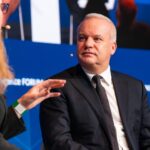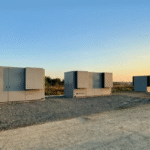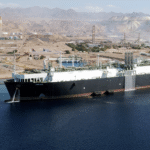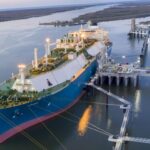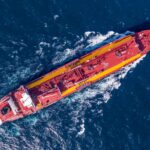Energy News Beat
Equinor’s strategic fine-tuning means renewable electricity growth will be less exclusively focused on offshore wind, although that remains critical, while oil and gas production will remain steady this decade, but pivoting increasingly toward natural gas. In an interview at the recent Energy Intelligence Forum, Equinor CEO Anders Opedal spoke about the challenges facing the Norwegian state-controlled major as it pursues a “balanced” energy transition. An edited transcript follows.
Q: I would like to start with addressing the elephant in the room, and that is the significant protester presence we have seen at this event. In fact, today’s event has been couched as ‘Their profit, our loss. Stop Rosebank.’ For those of you who may not be aware, Rosebank is an oil development that Equinor and partner Ithaca just recently sanctioned West of Shetland. It’s really become a lightning rod, a symbol for the anti-oil movement, seen as an indication of government and corporate lack of attention to the climate crisis. What are your impressions? What’s your response?
A: First of all, I do respect that they can actually protest. I think it’s important in a democracy that we have different views, that they’re allowed actually to do that protest because, obviously, in the energy transition there are no easy answers. Everything is a dilemma, and people will have different views on it. Personally, I really believe in a balanced energy transition. I believe we need Rosebank, as oil and gas will be needed in the energy transition. And our strategy is to invest in oil and gas and renewables and low carbon solutions. And that’s exactly what we do here in the UK. Dogger Bank, which came on stream just a few weeks ago, will be the world’s largest offshore wind park when it’s finished. That demonstrates the totality in our strategy. Having said that, Rosebank — a difficult decision. I spent a lot of time thinking about it, but in the end I think this is the right decision for the UK, and for Equinor.
Q: One of the things that seemed to inform that decision, and the UK government’s approval of it, is the work to reduce that carbon intensity. So you’re looking to electrify the operations. And I believe you put forward a number that the project will have a carbon intensity of about 3 kilograms CO2 equivalent per [barrel of oil equivalent], which is certainly top tier across the industry. What do efforts like that do to the breakeven for projects like Rosebank? Are they just on the margins, or do you really need the underlying resources to be that much better to cover these additional costs?
A: First of all, we have been working with reducing the CO2 emissions from our production for many, many years. Scope 1 and Scope 2 is our responsibility. So we have used power from shore on the Norwegian Continental Shelf for many years. We have developed this technology together with our suppliers, we have been able to lower the cost using power from shore. And that means that the average CO2 emission intensity per barrel is below 7 kg [CO2e/boe] for our portfolio. And of course, developing new oil fields today requires that we think very hard about how to produce that new oil and gas with as low emissions as possible. That’s why we work at Rosebank. We use all these types of technologies in Brazil to make sure that every new field we bring on stream will have as low emissions as possible. When you don’t have a carbon tax, it is an additional cost, but with carbon tax like we have in Norway, actually it is a positive NPV [net present value] when we do those kinds of investments.
Q: I would like to talk about breakevens more broadly across the industry. I think one of the things that we saw out of the Covid downturn is there was almost this race to the bottom from companies — how low can your breakeven go? And certainly this was to demonstrate portfolio resiliency, a commitment to capital discipline. But I do feel some of those comments have silently moved to the side as we sit amid cost inflation and even maybe in some corners decarbonization. What’s your sense of where breakevens are? Are there enough projects out there still to meet prior promises or might there have to be a little readjustment?
A: You know, we’re not immune to cost increases. Obviously, with the geopolitical tension, the war in Ukraine, our suppliers need to find new sub-suppliers. And that has a cost impact. But remember also that the break-even for a project is not only affected by the cost level from suppliers, it’s about the concept you select, the way you produce the oil and gas. We have seen these kind of challenges before. In 2014, when the oil price went down we had quite a high break-even as an industry, and as a company. We ran a project called STEP at that point in time, really looking into how we could improve our projects. And this is the same toolbox we’re using now, both in oil and gas, but also in renewables where we do see the same cost pressure. So it’s working together with suppliers looking at how can we improve this project. What does the concept look like? Can we include suppliers from the concept selection, even before, to really optimize this? This is how we work. And so keeping the break-even at a level that is investible.
Q: One of the things we heard yesterday from a number of contractors was this idea that because we have both oil and gas investments, but also renewables competing for that same contractor and supply chain space, it’s getting very tight. And so perhaps designs need to change, modularization and things of that sort may be required. Would you agree with that assessment?
A: Absolutely. Oil and gas used to be an industry where it was very much tailor-made, bespoke solutions every time. Since 2014, as an industry, we’ve moved beyond that, kind of working more integrated with suppliers, more modular designs etc. And basically, renewables is exactly that. So I think also here if we continue working together, and reuse and reuse, both we and the suppliers can be better off. And that is needed actually to be able to develop enough energy that the world needs.
Q: Going back to electrification efforts, I know in your home country it hasn’t been without controversy. There have been concerns that as wider industry use of clean energy picks up, that you could be stressing the system, raising prices for the average consumer. How are you navigating some of these challenges?
A: I think this is the same difficult challenge that many others see with this ‘not in my backyard’ — because, you know, if you use my power to power your oil and gas installations, maybe my power bill will be a bit higher or the local industry will not get the power. So that’s the debate we are having. But in Hammerfest up north in Norway we have an LNG plant, and that plant will now be powered from the shore. And that has created a lot of discussion because we need more power lines, more grids, and we need a lot of power, which people think could be used in the local communities instead. But at the same time, we also need to modernize the oil and gas industry. So by modernizing and using electrical power for producing LNG, we are able to support Europe with LNG that has no CO2 emissions while it’s being produced. And the LNG plant in Hammerfest is actually providing 6 million homes with gas every year here in Europe and the UK.
Q: I’d like to jump to the US and discuss government policy support for clean energy. Certainly, we’ve seen the Inflation Reduction Act has been heralded as this great boon for clean energy investment, although the application is a bit stalled while some guidance remains outstanding around the application of tax credits and things of that sort. But Equinor has been also on the front lines when it comes to, say, offshore wind and trying to work with state utilities in getting a price that allows the projects to be economic. Just [recently] one of your efforts to renegotiate was turned down. How do you see the landscape in the US right now? Where are the biggest impediments, and where can things still progress?
A: This is probably not just a US problem, I think it’s more of an offshore wind challenge at the moment. We could say that offshore wind has had its first kind of crisis. Coming from the oil and gas industry, we know that with those ups and downs what you do, you roll up your sleeves and start really working to make sure that you’re able to move the projects forward. And that’s exactly what we want to do with the offshore wind possibilities we have, including in the US. Of course, together with our partner BP, we were disappointed that this was turned down. But this is not the last word. We will continue working with our suppliers, working with local governments to find solutions that we’re able to move forward the offshore wind developments in the US.
Q: If you look more globally at offshore wind, how bad is it? There are so many headlines about how challenged it is. You get this sense that it’s doomed. So where does it sit? Is this temporary where we may see projects move a little more slowly, maybe the pipeline gets moved around a bit? Or are we looking at something where offshore wind’s viability is genuinely, systemically challenged versus solar, onshore wind, even nuclear?
A: Well, first of all I haven’t lost sleep, because I think offshore wind will be an important part of the energy transition and an important part of renewables. Remember, not all countries are able to develop huge solar parks and onshore wind farms. Many countries do need to have offshore wind as part of the energy mix. Obviously, as an offshore wind industry, we probably said too much that this is going to be very, very cost efficient very rapidly. And we have not allowed the suppliers to really make cost efficient manufacturing sites. Every time we have asked — can we have 12 megawatts [wind turbines], okay can we have 13 [MW], 14 [MW]? So there’s never been this time to really standardize. I think the industry and suppliers now really understand this and are working hard to take down the cost. Governments are working hard on the right method to award seabeds [licenses], support regimes and so on. So I’m absolutely sure in the long run, this will be a very, very good industry. We are well-positioned in this industry being in the US, the UK, Poland and also in Germany. And there are a lot of opportunities coming up in the future that we will definitely look into.
Q: One thing that we saw recently was the International Energy Agency updated its Net Zero by 2050 roadmap. And certainly, while the world is not on the right trajectory in that scenario. What did you find the most insightful or most applicable to Equinor as you keep tabs on how your strategy is faring?
A: I think it’s very important to say that we need a balanced energy transition. Any net-zero scenario tells us that this is going to be tough. But we’ll need a lot of CCS [carbon capture and storage], we will need a lot of hydrogen, we need more renewables and we still need oil and gas. Really, whatever scenario you look at, it’s more or less the same conclusion. And remember also that we haven’t really started on a global level on the energy transition yet. You know all the renewables is addition because of the increased energy we need. So my takeaway is that we need to invest more in renewables, we really need to make sure that CCS now is a viable technology — not to keep oil and gas longer in the mix, but because we need it to remove the CO2, particularly for the hard-to-abate heavy industry like steel and cement and so on. So, it needs to be a technology that is actually commercially attractive. We have the first project, Northern Lights, together with TotalEnergies and Shell that was sanctioned some years ago and next year this will be up and running. We’ll be actually taking CO2 from a facility in Holland and bringing it by ship to the west coast of Norway and pumping it to the subsurface on the Norwegian Continental Shelf and storing it there permanently and safely.
Q: Equinor sits in a unique position relative to most of the other companies in that you have your shareholder bases of the state, but then also private shareholders. If you reflect on the conversations you were having before the Ukraine crisis and now, how has the dialogue changed? Are the asks on you different? And are there differences between those two groups?
A: You know, the state and private investors, they really have the same view, I think. We have developed an energy transition plan, and we got a 97% approval rate for that at the AGM [annual general meeting]. So we have a very strong mandate to follow the strategy that we have. But you talked about the war. Governments that we serve with our energy were already talking more about climate ambitions and so on, before the war. But after the war, even in the autumn of 2021, our telephone started to really ring in Equinor. And the question was from Europe and the UK, can you provide us with more gas? And I think that has really been the theme over the last years — how we’ve been able to support governments and countries in North Europe with enough gas. One of the highlights so far in my career, I’ve been CEO for 3 years, was when I could take the secretary general of Nato and EU president and also the Norwegian prime minister to visit the Troll field where 10% of [European] gas demand is actually covered by this one facility. It’s 300 meters deep from the deck down to the bottom of the platform. And I took those three … down in an elevator. It was the longest elevator pitch I ever had. I had to tell them about Equinor and how we have developed. And at the bottom there are three export pipelines. Those pipelines actually [carry] 33% of the gas to Europe. And I think when [EU President] Ursula von der Leyen really kind of laid her hand on that pipe she saw the importance of energy security and how the oil and gas industry can also support countries.
Q: One thing that has been featured throughout our conversation so far is around the upcoming COP28 climate summit. I know you’ve attended in the past. Are you planning on going this year?
A: Well, it’s not finally settled, but at least I’m invited. I was there last time. I think it’s important. The energy transition is hard, dialogue is absolutely necessary and also this year Dr. Sultan [al-Jaber] is trying to lay a foundation for a dialogue. And when people invite you to a dialogue, you should show up. So that’s my starting point. I think our industry, the oil and gas industry, the energy industry and the other big emitters really need to sit down together and see how we can actually accelerate removing CO2. I hope as many companies as possible can sign up for this and that we can accelerate the way we decarbonize our industry. At the moment, we haven’t decarbonized anything by using renewables instead of fossil fuels. So it’s important to really reduce the CO2 from oil and gas production and heavy industry.
Q: You are hardly the first to mention the excitement about actually having the opportunity to be part of that dialogue at the upcoming COP. If you were to go, what specifically do you hope to be achieved? Is it just that people actually hear the message, that there’s more concrete elements of agreement, what would you be looking for?
A: As an industry, we emit quite a lot of methane and also CO2 while producing. We as a company have our targets together with other companies in the OGCI [Oil and Gas Climate Initiative]. We hope that what we have done can inspire others as well to do the same, such that we as an industry are able to contribute much more than we do today because our product, oil and gas, will be needed for a while, but the way we produce it really matters.
Q: Brazil is certainly a country where you have been very active, you’ve made renewables acquisitions. I know you’re partnering with Petrobras to evaluate offshore wind developments and you have recently sanctioned an oil and gas development. As your business interests diversify, how does it perhaps change how you look at the geography of your portfolio? And do certain places rise up in new ways because of the oil, and gas and renewables elements?
A: Basically, we have been able to shrink our oil and gas portfolio in terms of geographical footprint. We took a hard look at many countries and saw what is core and what is non-core. And a typical core country now is a country where we are able to provide oil and gas but also the opportunities to provide either CCS, hydrogen or electricity such that we are a partner with the government there through the energy transition. Brazil is one of those countries. We have quite a large footprint in terms of oil and gas with Peregrino that we developed 20 years ago. We are the first international operator actually operating a field inside the presalt polygon and we’re developing another gas field there as well, in addition to the partnership with Petrobras. We’ve just recently bought Rio Energy, a company that does onshore wind and solar, and we have a solar plant there from before, and we’re building another one. So we’re broadening out in Brazil. But we’re focusing in those countries that we’re already working in.
ENB Top News
ENB
Energy Dashboard
ENB Podcast
ENB Substack
The post Equinor CEO: ‘Different Views’ on Transition Needed for Balance appeared first on Energy News Beat.

